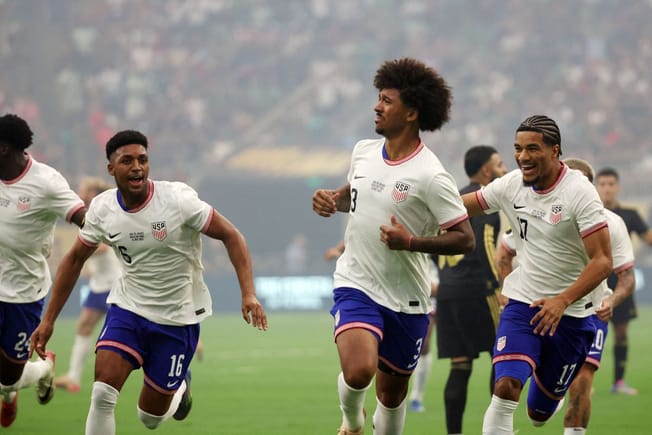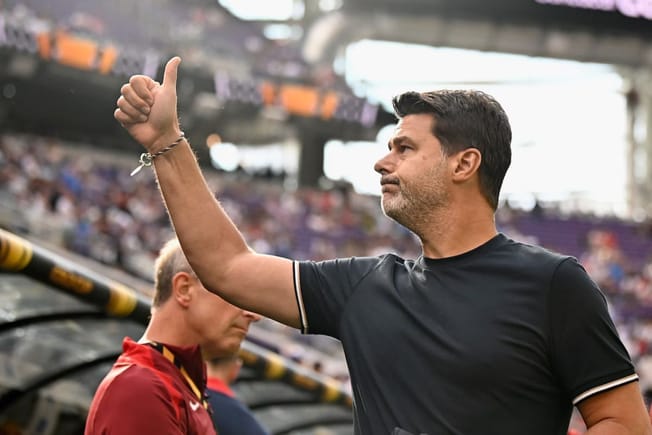Quick Hits
- While much of the discussion around the United States men’s national team focuses on the team’s attacking struggles, its strong defending could power a World Cup run
- Under Gregg Berhalter, the U.S. has developed a promising defensive setup
The United States men’s national team is in San Salvador.
The U.S. is playing its first game of the Concacaf’s 2022 World Cup qualifying cycle… and it can’t seem to put the ball in the back of the net. Though the team talked up a “nine-point week” before the qualifying campaign started back in September, 2021, the match against El Salvador ended with a frustrating 0-0 draw. Well, there goes the nine-point week.
The United States couldn’t get on the scoresheet in its first qualifier and the U.S. couldn’t get on the scoresheet one year later in its final two games before the World Cup, either.
Gregg Berhalter’s team was shut out in a 2-0 loss to Japan and a 0-0 draw with Saudi Arabia in September of this year. Though Berhalter has sought to “change the way the world views American soccer” by becoming a better possession team, the U.S. hasn’t made much progress in that area. In fact, it’s become increasingly clear that if the USMNT hopes to make a run in Qatar, it won’t be because it expertly plays through pressure or breaks down a compact opponent.
No, if the U.S. makes a run at the World Cup, it will be because of its impressive play in another part of the game. Oh, what’s that? You haven’t heard about this part of the USMNT? Well, let us fill you in. The USMNT has a superpower.
It’s very, very good at defending.
HOW DOES THE U.S. DEFEND?
While Berhalter discussed how his team was going to wear the opposition down with “every pass” when he first took over the USMNT, the team’s steady and often aggressive defending has become its biggest tactical weapon.
“We press. We press relentlessly. We don’t stop pressing and it just breaks team’s rhythms,” Berhalter told ESPN earlier this year. “[Opposing teams] will get some chances against us if they break the press, but it’s not easy.”
Under Berhalter, the U.S. defends in a 4-3-3 shape and often presses in the attacking half. Here’s a look at the USMNT’s defensive shape, taken from their 2-0 home win over Mexico in World Cup qualifying. You can see the front three high up the field, the two No. 8s stepping forward behind them, and left back Antonee Robinson involved in the action, too.

The U.S. will pick their moments to defend deeper, but the narrow 4-3-3 shape has become a staple for this team.
NEW AND IMPROVED DEFENSE
Now, we won’t truly know how high this team’s defensive ceiling is until the World Cup starts, but we do have some promising indicators.
First, the defense has been noticeably better under Berhalter than it was in the previous two World Cup qualifying cycles. In the 2014 cycle, the U.S. allowed 0.8 goals per game in qualifying and one per game in regulation at the World Cup. As a point of comparison, Costa Rica only conceded 0.7 in qualifying, allowed just one goal in the group stage, and one more in its two knockout games. Then in the 2018 cycle, the U.S. missed the World Cup after conceding 1.3 goals per game.
Fast forward to 2022, and, while everyone loves to focus on the U.S.’s inconsistent attack, what really matters is the defending – oh, and set pieces. More on that in a bit. In the 2022 Concacaf Octagonal, the USMNT gave up just 0.7 goals per game while allowing the smallest amount of expected goals (xG) in Concacaf.
The Ocho xG numbers themselves: pic.twitter.com/fT80FEqDbF
— Paul Carr (@PaulCarr) March 31, 2022
With better defensive statistics and good xG numbers, we can see the United States’ defense has improved.
HOW TO DEFEND AT THE WORLD CUP
Now, one of the issues with any World Cup or World Cup qualifying analysis is the small sample sizes. There are 380 games in an English Premier League season, but just 64 games in the current FIFA men’s World Cup format and a total of 56 in the qualifying format Concacaf used to get teams to the tournament. With so few games, it’s tough to draw absolute conclusions.
But, we’re still doing our best with what we have.
In the 2018 World Cup, there were 2.45 goals per game in regulation, compared to 2.9 in MLS in 2022 and 2.8 in the “Big 5” European leagues in the 2021-22 season. Here’s a breakdown of open-play, set pieces, and penalty goals between those three competitions.

As you can see in the chart, quality open-play chances are far tougher to come by at World Cups than they are at the club level. Why? Well, at least in part because international coaches don’t have as much time to drill attacking patterns as club coaches do. While certain types of passes like through balls and cutbacks are important keys to club success, they don’t impact attacking play quite as much in a World Cup setting.
To have a good defense on the world’s stage, though, you still have to stop teams in open-play. And you really have to avoid giving up set piece goals and penalties. England manager Gareth Southgate understood this well in the 2018 World Cup, taking tips from the NFL and the NBA and creating set plays that powered England into the semifinals.
Taking all of that into account, the key to a good defensive performance at the international level is to…
- Avoid mistakes in the back
- Don’t concede high-probability open-play goals
- Defend for your lives on set pieces
THE NUMBERS LOVE THE USMNT
Those three points, mixed with the data up above, paints the USMNT in a favorable light ahead of the World Cup. Let’s dig deeper into their numbers.
During qualifying, the United States’ press was the best at winning the ball in both the opponent’s third and the middle third by a good margin. Those pressing wins deny opponents chances to develop attacks – and they can lead to transition opportunities for the U.S. before the opponent’s defense is set. The U.S. also won the most 50/50 balls and had the best win percentage in duels, thanks to their counter pressing and aerial ability.
Speaking of counter pressing, the U.S. allowed the fewest shots per opposing counter attempt in qualifying, which is a good indication of their ability to recover after losing the ball. With players like Brenden Aaronson, Tyler Adams, Weston McKennie, Walker Zimmerman, and Robinson, the U.S. has a strong group of active defenders in every line of the field.
Brenden Aaronson ran 13.2km yesterday against Liverpool, the most distance covered by a player in a Premier League match this season. #lufc pic.twitter.com/NX0fErPNYP
— Jonny Cooper (@JRCooper26) October 30, 2022
Because of the team’s pressing ability, opponents don’t get the chance to take many shots against the United States. The USMNT allowed the second fewest shots in Concacaf and took the fewest goal kicks by a sizable margin, which is a good indication the team wasn’t in emergency defending mode very often.
Berhalter’s team defended well in qualifying – and it also defended intelligently. Dead balls are really, really important in tournament play, so the data tells us the biggest factors impacting goal differential are set pieces and, most importantly, not conceding penalties. The USMNT committed the fewest fouls and received the fewest yellow cards in the region, reducing the chances of conceding a goal on a set piece. With that in mind, the U.S. conceded the second fewest set piece shots and they didn’t concede any penalties in qualifying.
It’s not just qualifying, though. The U.S. also held Japan to relatively little in their game back in September, although they lost 2-0, and didn’t let Uruguay run rampant in a 0-0 draw back in June. Those are two very dangerous World Cup teams.
— Paul Carr (@PaulCarr) September 23, 2022
After watching this team find its identity under Berhalter, it’s become increasingly clear that its defensive work is a strong point.
MATT TURNER, THE X-FACTOR?
Before we close, we’d be foolish not to point out the USMNT’s biggest asset: goalkeeper Matt Turner. The current Arsenal goalkeeper lit up MLS during his time in the league with the New England Revolution. I mean, just look at his MLS save percentage relative to his peers since 2018.

On top of those numbers above, Turner saved an absolutely insane 92% of counter attacking shots, compared to 69% from his peers. He also saved twice as many penalties as his peers and has never given up a direct freekick goal in MLS.
If the same Turner who helped lead the Revolution to a Supporters’ Shield in MLS shows up at the World Cup, he could will the USMNT out of Group B. Add in the strong defensive setup in front of him and, well, that could lead to something even bigger for the United States.
The U.S. is still prone to frustrating moments, like that 0-0 draw to an inferior El Salvador team or a destructive attacking performance against Japan with time running out before the World Cup. But the USMNT’s true superpower – its defense – just might be enough to help them make a run at this tournament.







Comments